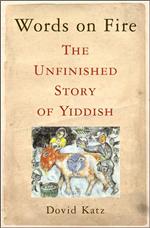Words on Fire: The Unfinished Story of Yiddish, by Dovid Katz; Basic Books, 2009, 512 pages, $30.95.
The objective of this book is to restore the flagging state of the Yiddish language—its past and present reputation and future prospects. Yiddish has long been divisive among Jews. Some deplore it as “jargon”, others love it as the expressive communal language of the Eastern European Jews.
It arose more than a thousand years ago in the Jewish ghettos of German towns, where local dialects fused with Hebrew. The medieval persecutions, restrictions and expulsions there saw mass emigration to the old Polish-Lithuanian state, which then covered a larger area than modern Poland and where the kings welcomed the Jews for their ability to develop towns in these primitive regions.
Other Jews followed and over a millennium a community of 10 million or so resulted. In a multicultural region with diverse languages and shifting borders, a separate communal language was not as unusual as it might seem today.
The Holocaust of the early 1940s brought death to most of the Yiddish speakers; others fled to Israel and elsewhere. Hebrew was by then the language of Israel, effectively if artificially revived and not favouring Jews of European background, as Yiddish would have. For those who stayed in Eastern Europe, the centralising Soviet era was no help either.
Meanwhile, the language was declining rapidly in favour of English in the Jewish immigrant communities of New York, London and elsewhere, which had received most of their Yiddish-speaking newcomers before the First World War.
It might be a small sign of some kind of spring that this American-born author has taught at Oxford and now teaches and directs research at the Vilnius Yiddish Institute in Lithuania. Vilnius was once a major centre of Eastern European Jewry.
Dovid Katz, son of a New York Yiddish scholar, says Yiddish in its heyday a century ago was full of vitality, with a rich literature, despite its limited population.He says its future for numbers of speakers seems to lie with the world’s ultra-orthodox Jewish communities, who encourage it but whose religious views he does not accept. Their literary output is mostly either religious or children’s works, often translated from English. This book is a call for it to be rescued from this contemporary ghetto.
He says Hebrew is not quite the “pure” language it is often claimed to be. Like Yiddish, it was a “fusion” language itself, when the Aramaic spoken by immigrants to Palestine, like the founding father, Abraham, from what is now Iraq, fused with the local Canaanite language. After several hundred years, the Jews of Palestine returned to Aramaic, the language of Jesus, which is still spoken in remote parts of the Middle East where it has not yet given way to Arabic. (All are related tongues.) Hebrew, however, was used when most of what Christians call the Old Testament was being written about 400 to 500 years BC. Aramaic is still used in the Talmud.
There has been debate over whether anti-Semitism was a minor or more middling issue in pre-Nazi Europe. Katz is on the “minor” side. He says Eastern Europe was largely free of serious anti-Semitism, except for massacres in Ukraine as part of the Thirty Years War in the seventeenth century. Even the anti-Jewish pogroms of late Tsarist Russia and the turmoil right after the First World War affected only a minority of the Jewish population. In pre-Hitler Germany the main Jewish issue was rapid assimilation. The Holocaust could not have been foreseen anywhere until it happened, he says.
Jewish emigration from Eastern Europe, though massive between the 1880s and the First World War, was overwhelmingly economic. Remaining Jews were often critical of emigrants, as deserting a truly Jewish ambience for the secular West. They could also be snobbish about it as lower class.
Enthusiasts will welcome Katz’s extensive bibliography of literature in and about Yiddish.
Robert Murray is a frequent contributor to Quadrant on history.
 Sign In
Sign In 0 Items (
0 Items ( Search
Search








